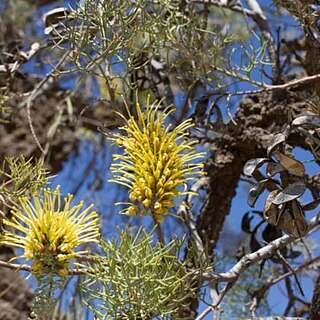A tall shrub or small tree. It grows 4-7 m high and spreads 2-4 m wide. The bark is dark grey and deeply cracked. The small branches have white hairs. The leaves are 2-9.5 cm long and compound. They are divided into 4-15 stiff segments. These are grey-green and hairy. They are 6 cm long and have sharp tips. The flowering stalks are 5-16 cm long and in the axils of leaves. They bear 35-105 flowers. These are plump and yellow. The fruit is 2.5-4.2 cm long by 1-1.2 cm wide. They are narrow, oval and smooth. They have a long broad beak.


